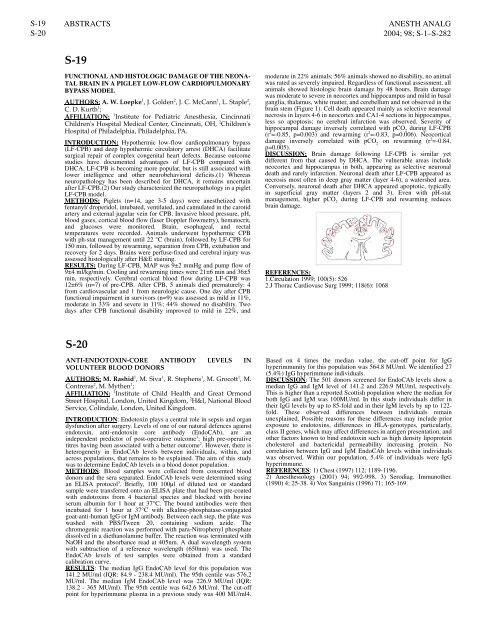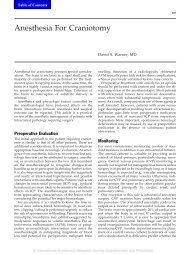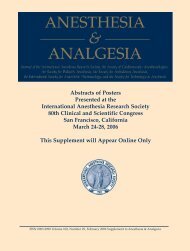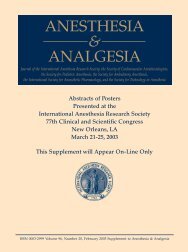ANESTHESIA & ANALGESIA - IARS
ANESTHESIA & ANALGESIA - IARS
ANESTHESIA & ANALGESIA - IARS
Create successful ePaper yourself
Turn your PDF publications into a flip-book with our unique Google optimized e-Paper software.
S-19<br />
S-20<br />
ABSTRACTS ANESTH ANALG<br />
2004; 98; S-1–S-282<br />
S-19<br />
FUNCTIONAL AND HISTOLOGIC DAMAGE OF THE NEONA-<br />
TAL BRAIN IN A PIGLET LOW-FLOW CARDIOPULMONARY<br />
BYPASS MODEL<br />
AUTHORS: A. W. Loepke 1 , J. Golden 2 , J. C. McCann 1 , L. Staple 2 ,<br />
C. D. Kurth 1 ;<br />
AFFILIATION: 1 Institute for Pediatric Anesthesia, Cincinnati<br />
Children's Hospital Medical Center, Cincinnati, OH, 2 Children's<br />
Hospital of Philadelphia, Philadelphia, PA.<br />
INTRODUCTION: Hypothermic low-flow cardiopulmonary bypass<br />
(LF-CPB) and deep hypothermic circulatory arrest (DHCA) facilitate<br />
surgical repair of complex congenital heart defects. Because outcome<br />
studies have documented advantages of LF-CPB compared with<br />
DHCA, LF-CPB is becoming more popular, but is still associated with<br />
lower intelligence and other neurobehavioral deficits.(1) Whereas<br />
neuropathology has been described for DHCA, it remains uncertain<br />
after LF-CPB.(2) Our study characterized the neuropathology in a piglet<br />
LF-CPB model.<br />
METHODS: Piglets (n=14, age 3-5 days) were anesthetized with<br />
fentanyl/ droperidol, intubated, ventilated, and cannulated in the carotid<br />
artery and external jugular vein for CPB. Invasive blood pressure, pH,<br />
blood gases, cortical blood flow (laser Doppler flowmetry), hematocrit,<br />
and glucoses were monitored. Brain, esophageal, and rectal<br />
temperatures were recorded. Animals underwent hypothermic CPB<br />
with ph-stat management until 22 °C (brain), followed by LF-CPB for<br />
150 min, followed by rewarming, separation from CPB, extubation and<br />
recovery for 2 days. Brains were perfuse-fixed and cerebral injury was<br />
assessed histologically after H&E staining.<br />
RESULTS: During LF-CPB, MAP was 9±2 mmHg and pump flow of<br />
9±4 ml/kg/min. Cooling and rewarming times were 21±6 min and 36±5<br />
min, respectively. Cerebral cortical blood flow during LF-CPB was<br />
12±6% (n=7) of pre-CPB. After CPB, 5 animals died prematurely: 4<br />
from cardiovascular and 1 from neurologic cause. One day after CPB<br />
functional impairment in survivors (n=9) was assessed as mild in 11%,<br />
moderate in 33% and severe in 11%; 44% showed no disability. Two<br />
days after CPB functional disability improved to mild in 22%, and<br />
S-20<br />
ANTI-ENDOTOXIN-CORE ANTIBODY LEVELS IN<br />
VOLUNTEER BLOOD DONORS<br />
AUTHORS: M. Rashid 1 , M. Siva 1 , R. Stephens 1 , M. Grocott 1 , M.<br />
Contreras 2 , M. Mythen 1 ;<br />
AFFILIATION: 1 Institute of Child Health and Great Ormond<br />
Street Hospital, London, United Kingdom, 2 H&I, National Blood<br />
Service, Colindale, London, United Kingdom.<br />
INTRODUCTION: Endotoxin plays a central role in sepsis and organ<br />
dysfunction after surgery. Levels of one of our natural defences against<br />
endotoxin, anti-endotoxin core antibody (EndoCAb), are an<br />
independent predictor of post-operative outcome 1 ; high pre-operative<br />
titres having been associated with a better outcome 2 . However, there is<br />
heterogeneity in EndoCAb levels between individuals, within, and<br />
across populations, that remains to be explained. The aim of this study<br />
was to determine EndoCAb levels in a blood donor population.<br />
METHODS: Blood samples were collected from consented blood<br />
donors and the sera separated. EndoCAb levels were determined using<br />
an ELISA protocol 3 . Briefly, 100 100µl of diluted test or standard<br />
sample were transferred onto an ELISA plate that had been pre-coated<br />
with endotoxins from 4 bacterial species and blocked with bovine<br />
serum albumin for 1 hour at 37°C. The bound antibodies were then<br />
incubated for 1 hour at 37°C with alkaline-phosphatase-conjugated<br />
goat-anti-human IgG or IgM antibody. Between each step, the plate was<br />
washed with PBS/Tween 20, containing sodium azide. The<br />
chromogenic reaction was performed with para-Nitrophenyl phosphate<br />
dissolved in a diethanolamine buffer. The reaction was terminated with<br />
NaOH and the absorbance read at 405nm. A dual wavelength system<br />
with subtraction of a reference wavelength (650nm) was used. The<br />
EndoCAb levels of test samples were obtained from a standard<br />
calibration curve.<br />
RESULTS: The median IgG EndoCAb level for this population was<br />
141.2 MU/ml (IQR: 84.9 - 238.4 MU/ml). The 95th centile was 576.2<br />
MU/ml. The median IgM EndoCAb level was 226.9 MU/ml (IQR:<br />
138.2 - 365 MU/ml). The 95th centile was 642.6 MU/ml. The cut-off<br />
point for hyperimmune plasma in a previous study was 400 MU/ml4.<br />
moderate in 22% animals; 56% animals showed no disability, no animal<br />
was rated as severely impaired. Regardless of functional assessment, all<br />
animals showed histologic brain damage by 48 hours. Brain damage<br />
was moderate to severe in neocortex and hippocampus and mild in basal<br />
ganglia, thalamus, white matter, and cerebellum and not observed in the<br />
brain stem (Figure 1). Cell death appeared mainly as selective neuronal<br />
necrosis in layers 4-6 in neocortex and CA1-4 sections in hippocampus,<br />
less so apoptosis; no cerebral infarction was observed. Severity of<br />
hippocampal damage inversely correlated with pCO 2 during LF-CPB<br />
(r 2 =-0.85, p=0.003) and rewarming (r 2 =-0.83, p=0.006). Neocortical<br />
damage inversely correlated with pCO 2 on rewarming (r 2 =-0.84,<br />
p=0.005).<br />
DISCUSSION: Brain damage following LF-CPB is similar yet<br />
different from that caused by DHCA. The vulnerable areas include<br />
neocortex and hippocampus in both, appearing as selective neuronal<br />
death and rarely infarction. Neuronal death after LF-CPB appeared as<br />
necrosis most often in deep gray matter (layer 4-6), a watershed area.<br />
Conversely, neuronal death after DHCA appeared apoptotic, typically<br />
in superficial gray matter (layers 2 and 3). Even with pH-stat<br />
management, higher pCO 2 during LF-CPB and rewarming reduces<br />
brain damage.<br />
REFERENCES:<br />
1.Circulation 1999; 100(5): 526<br />
2.J Thorac Cardiovasc Surg 1999; 118(6): 1068<br />
Based on 4 times the median value, the cut-off point for IgG<br />
hyperimmunity for this population was 564.8 MU/ml. We identified 27<br />
(5.4%) IgG hyperimmune individuals.<br />
DISCUSSION: The 501 donors screened for EndoCAb levels show a<br />
median IgG and IgM level of 141.2 and 226.9 MU/ml, respectively.<br />
This is higher than a reported Scottish population where the median for<br />
both IgG and IgM was 100MU/ml. In this study individuals differ in<br />
their IgG levels by up to 85-fold and in their IgM levels by up to 122fold.<br />
These observed differences between individuals remain<br />
unexplained. Possible reasons for these differences may include prior<br />
exposure to endotoxins, differences in HLA-genotypes, particularly,<br />
class II genes, which may affect differences in antigen presentation, and<br />
other factors known to bind endotoxin such as high density lipoprotein<br />
cholesterol and bactericidal permeability increasing protein. No<br />
correlation between IgG and IgM EndoCAb levels within individuals<br />
was observed. Within our population, 5.4% of individuals were IgG<br />
hyperimmune.<br />
REFERENCES: 1) Chest (1997) 112; 1189-1196.<br />
2) Anesthesiology (2001) 94; 992-998. 3) Serodiag. Immunother.<br />
(1990) 4; 25-38. 4) Vox Sanguinis (1996) 71; 165-169.





